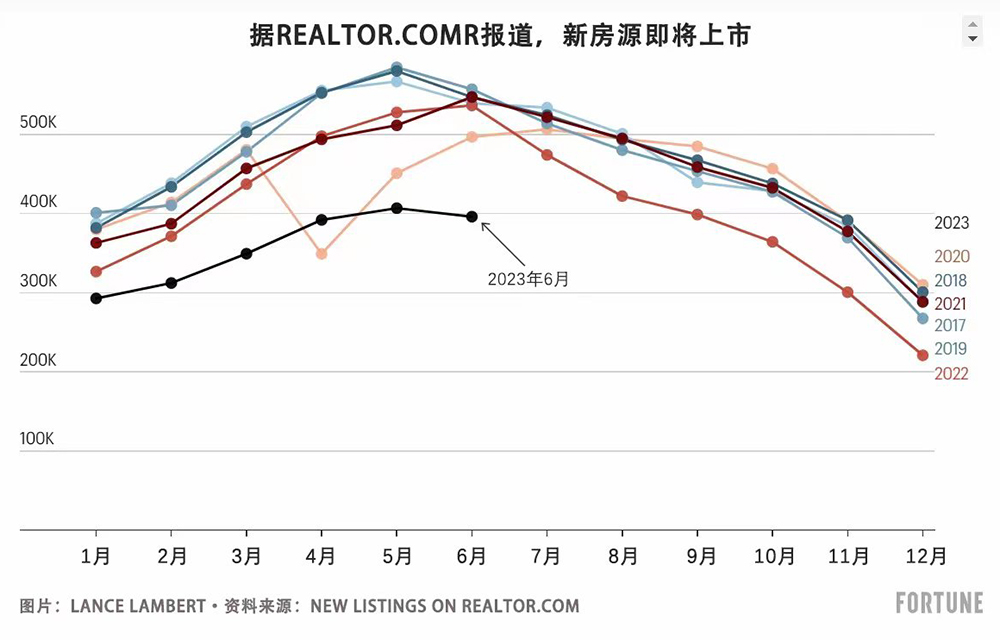
在两种相互冲突的力量影响下,美国房地产市场卷入了一场激烈的斗争。一方面,在新冠疫情期间的房地产热潮(Pandemic Housing Boom)中,全美房价暴涨超过40%,随后不久,在2022年,抵押贷款利率从3%飙升至超过6%,导致可负担性下降,从而带来了房价下行压力。另一方面,所谓的“锁定效应”加剧了现有房屋库存短缺,许多业主不愿意卖房和买新房,因为他们担心2%或3%的抵押贷款利率将变成6%至7%,这带来了房价上行压力。
房地产经济学家表示,这两种力量都不容忽视。
2022年抵押贷款利率上涨令许多潜在购房人措手不及,降低了购房人的购买力和房屋的可负担性。随着抵押贷款利率在短期内提高了一倍,亚特兰大联邦储备银行(Federal Reserve Bank of Atlanta)跟踪的住宅可负担性(或者更贴切地说是可负担性不足)达到了自2006年房地产泡沫最严重时期以来的最高水平。可负担性不足导致去年秋天房价回调,对过热的西南部和西海岸房地产市场造成了最大影响。可负担性危机让许多潜在购房人选择继续观望,这导致需求下降,房屋销售增速放缓。
与此同时,房地产市场还面临可售房屋库存不足的问题。锁定效应,即业主因为担心要承担更高的抵押贷款利率而不愿意卖房的现象,导致市场上现有住宅存量不足。一直享受低利率的业主不愿意放弃有利的融资条款,导致房地产供应出现了瓶颈。Realtor.com的数据显示,2023年6月挂牌待售房源数量比2022年6月减少了26.2%,比2019年6月减少了28.9%。房源有限加剧了购房人的竞争,导致今年上半年大多数市场房价上涨。通常来说,上半年是房产销售旺季。

为了更好地了解“锁定效应”,我们需要了解一个事实,那就是有91%的抵押贷款借款人利率低于5%,有70.7%的购房人利率低于4%。对这些业主而言,卖掉现有的房子,再以当前6%或7%的抵押贷款利率买一套房子,这显然是不合理的。

不止潜在购房人和卖房人感受到了压力,依靠房屋交易量维持生计的房地产从业者也受到了影响。随着住宅可负担性的持续恶化和可售房屋短缺,房产中介和经纪商只能努力利用有限的机会完成销售和赚取佣金。成交量减少影响了他们的财务稳定性,使一些公司出现生存危机。
哪种力量将占据上风?紧张的可负担性会导致全美房价进一步下跌,还是现有房屋库存不足使全美房价上涨?
Zillow和CoreLogic等公司认为全美房价已经跌至最低点,它们预测未来12个月房价会继续上涨。它们表示,现有房屋库存不足使购房人别无选择,这会导致房价上涨。
穆迪分析(Moody's Analytics)的首席经济学家马克·赞迪持不同观点。他预测未来几年,随着抵押贷款利率缓慢从2023年的约6.5%下降到2025年的5.5%,以及全美房价从最高点到最低点最终下跌约8%,住宅可负担性将有所改善。换言之,赞迪预计可负担性不足会占据上风。
赞迪对《财富》杂志表示:“我们认为,未来三年房价会持续下跌,但不会发生暴跌,而是一个缓慢而漫长的过程。”
如果赞迪团队的预测是错误的,并且“房价最终高于预期”,他认为原因将是当前的锁定效应,即人们选择观望,而房屋库存不足继续推高全国房价。(财富中文网)
译者:刘进龙
审校:汪皓
在两种相互冲突的力量影响下,美国房地产市场卷入了一场激烈的斗争。一方面,在新冠疫情期间的房地产热潮(Pandemic Housing Boom)中,全美房价暴涨超过40%,随后不久,在2022年,抵押贷款利率从3%飙升至超过6%,导致可负担性下降,从而带来了房价下行压力。另一方面,所谓的“锁定效应”加剧了现有房屋库存短缺,许多业主不愿意卖房和买新房,因为他们担心2%或3%的抵押贷款利率将变成6%至7%,这带来了房价上行压力。
房地产经济学家表示,这两种力量都不容忽视。
2022年抵押贷款利率上涨令许多潜在购房人措手不及,降低了购房人的购买力和房屋的可负担性。随着抵押贷款利率在短期内提高了一倍,亚特兰大联邦储备银行(Federal Reserve Bank of Atlanta)跟踪的住宅可负担性(或者更贴切地说是可负担性不足)达到了自2006年房地产泡沫最严重时期以来的最高水平。可负担性不足导致去年秋天房价回调,对过热的西南部和西海岸房地产市场造成了最大影响。可负担性危机让许多潜在购房人选择继续观望,这导致需求下降,房屋销售增速放缓。
与此同时,房地产市场还面临可售房屋库存不足的问题。锁定效应,即业主因为担心要承担更高的抵押贷款利率而不愿意卖房的现象,导致市场上现有住宅存量不足。一直享受低利率的业主不愿意放弃有利的融资条款,导致房地产供应出现了瓶颈。Realtor.com的数据显示,2023年6月挂牌待售房源数量比2022年6月减少了26.2%,比2019年6月减少了28.9%。房源有限加剧了购房人的竞争,导致今年上半年大多数市场房价上涨。通常来说,上半年是房产销售旺季。
为了更好地了解“锁定效应”,我们需要了解一个事实,那就是有91%的抵押贷款借款人利率低于5%,有70.7%的购房人利率低于4%。对这些业主而言,卖掉现有的房子,再以当前6%或7%的抵押贷款利率买一套房子,这显然是不合理的。
不止潜在购房人和卖房人感受到了压力,依靠房屋交易量维持生计的房地产从业者也受到了影响。随着住宅可负担性的持续恶化和可售房屋短缺,房产中介和经纪商只能努力利用有限的机会完成销售和赚取佣金。成交量减少影响了他们的财务稳定性,使一些公司出现生存危机。
哪种力量将占据上风?紧张的可负担性会导致全美房价进一步下跌,还是现有房屋库存不足使全美房价上涨?
Zillow和CoreLogic等公司认为全美房价已经跌至最低点,它们预测未来12个月房价会继续上涨。它们表示,现有房屋库存不足使购房人别无选择,这会导致房价上涨。
穆迪分析(Moody's Analytics)的首席经济学家马克·赞迪持不同观点。他预测未来几年,随着抵押贷款利率缓慢从2023年的约6.5%下降到2025年的5.5%,以及全美房价从最高点到最低点最终下跌约8%,住宅可负担性将有所改善。换言之,赞迪预计可负担性不足会占据上风。
赞迪对《财富》杂志表示:“我们认为,未来三年房价会持续下跌,但不会发生暴跌,而是一个缓慢而漫长的过程。”
如果赞迪团队的预测是错误的,并且“房价最终高于预期”,他认为原因将是当前的锁定效应,即人们选择观望,而房屋库存不足继续推高全国房价。(财富中文网)
译者:刘进龙
审校:汪皓
In a clash of opposing forces, the U.S. housing market finds itself embroiled in a fierce battle. On one side, deteriorated affordability resulting from a spike in mortgage rates from 3% to over 6% in 2022, just after national home prices surged by more than 40% during the Pandemic Housing Boom, is exerting downward pressure on home prices. On the other side, the scarcity of existing inventory, exacerbated by the so-called “lock-in effect,” as many homeowners are reluctant to sell and buy anew, fearing the trade-off from a 2% or 3% mortgage rate to one in the 6% to 7% range, is exerting upward pressure on home prices.
Housing economists say neither force should be ignored.
The surge in mortgage rates in 2022 caught many prospective buyers off guard, diminishing their purchasing power and making homeownership less affordable. With mortgage rates doubling in such a short period, housing affordability (or better put the lack of affordability) as tracked by the Federal Reserve Bank of Atlanta has reached levels unseen since the height of the bubble in 2006. That affordability crunch translated into a home price correction last fall, which packed its biggest punch in overheated Southwest and West Coast markets. That affordability crisis continues to leave many potential buyers on the sidelines, thwarting demand and leading to a slowdown in home sales.
Simultaneously, the housing market is being strained by a lack of available inventory. The lock-in effect, a term used to describe homeowners’ hesitance to sell their properties due to the fear of higher mortgage rates, has resulted in a dearth of existing homes on the market. Homeowners, enjoying historically low interest rates, are reluctant to relinquish their favorable financing terms, creating a bottleneck in the housing supply. According to Realtor.com, there were 26.2% fewer homes listed for sale in June 2023 than in June 2022, and 28.9% fewer than in June 2019. This limited inventory has fueled competition among buyers, and caused home prices to rise in the first half of the year—the seasonally strong part of the year—in most markets.
To better understand the "lock-in effect," consider the fact that 91% of mortgage borrowers have an interest rate below 5%, including 70.7% with an interest rate below 4%. For those homeowners, it simply doesn't make a lot of sense to sell and purchase a property right now at a 6% or 7% mortgage rate.
It is not just prospective buyers and sellers feeling the strain; the ramifications extend to the real estate professionals who depend on transaction volume to make a living. With the rapid deterioration of housing affordability and the scarcity of available homes, real estate agents and brokers are grappling with limited opportunities to facilitate sales and earn commissions. The dwindling transaction volumes have dealt a blow to their financial stability and jeopardized the viability of some businesses.
So who will win out? Will strained affordability see national home prices drift lower, or will a lack of existing inventory drive national prices higher?
According to firms like Zillow and CoreLogic, national house prices have already hit bottom and are projected to continue rising over the next 12 months. The scarcity of existing inventory, they say, leaves buyers with no choice but to drive prices higher.
Moody's Analytics chief economist Mark Zandi holds a different view. He anticipates housing affordability will improve over the next few years, as mortgage rates slowly drift from around 6.5% in 2023 to 5.5% in 2025, and as national house prices ultimately fall around 8% from peak-to-trough. In other words, Zandi expects strained affordability to overcome the lack of inventory.
"In our thinking this [price] weakness plays out over the next three years, there's no cliff event here, it's more of a slow grind lower," Zandi tells Fortune.
If, by any chance, Zandi's team is mistaken and "prices end up being stronger than anticipated," he asserts that it would be due to the prevailing lock-in effect, as individuals choose to hunker down and the shortage of inventory continues to drive national house prices upward.






